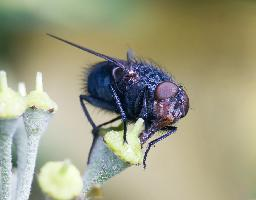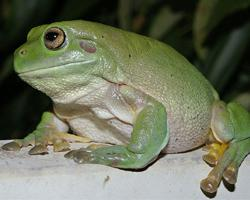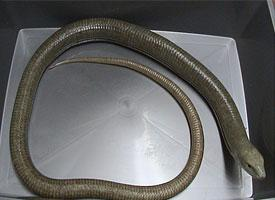
Poids et mesures
| Longueur | de 10 à 14 mm |
|---|
Description de l'animal
The Blue Bottle Fly, scientifically known as Calliphora vomitoria, is a fascinating species belonging to the family Calliphoridae, commonly referred to as blowflies. These insects are not only known for their distinctive appearance but also for their ecological importance and role in forensic science.Characterized by its vibrant metallic blue color, the Blue Bottle Fly possesses a stout body structure, typically measuring between 10 to 14 millimeters in length. The brilliance of its coloration is not just for show; it serves as a deterrent against predators by signaling potential toxicity or unpalatability. This fly has large, red compound eyes that provide a wide field of vision, crucial for detecting movement and navigating through its environment. The wings are clear with a slight tinge of brown at the edges, and when at rest, they are folded neatly over the abdomen.
The life cycle of the Blue Bottle Fly is both fascinating and a bit morbid. Females lay their eggs in decaying organic matter, such as carcasses, garbage, or feces, providing a nutrient-rich environment for the emerging larvae. These larvae, commonly referred to as maggots, are voracious eaters and play a critical role in decomposing and recycling organic material back into the ecosystem. After several days of feeding and growth, the larvae pupate, emerging as adults ready to continue the cycle.
Adult Blue Bottle Flies are primarily nectar feeders, visiting flowers for sustenance. However, their larvae are known for their less appealing dietary preferences. This distinction highlights the dual role these flies play in both pollination and decomposition within their ecosystems.
Interestingly, the Blue Bottle Fly has also found its place in forensic entomology, the study of insects and their developmental stages to estimate time of death. Because these flies are among the first to arrive at a decomposing body and have a well-documented life cycle, they can provide valuable information in criminal investigations.
Despite their contributions to the environment and science, Blue Bottle Flies are often considered pests due to their attraction to and breeding in unsanitary conditions. This can lead to the spread of diseases, as they can pick up and transport various pathogens due to their feeding and breeding habits.
In conclusion, the Blue Bottle Fly is a creature of contrast, embodying both the beauty and the grotesque. Its shimmering appearance and ecological role make it a subject of interest and importance, despite the often negative perception that follows its species. Whether it's contributing to the cycle of life through decomposition or aiding in the pursuit of justice in forensic investigations, the Blue Bottle Fly undeniably leaves a significant mark on the natural world and human society.
Animaux similaires
Nouvelles photos d'animaux
Top 10 des animaux
- Common reed warbler (Acrocephalus scirpaceus)
- Diana monkey (Cercopithecus diana)
- Moustached guenon (Cercopithecus cephus)
- Galápagos tortoise (Geochelone nigra complex)
- Dolphin gull (Leucophaeus scoresbii)
- Hen harrier (Circus cyaneus)
- Brant (Branta bernicla)
- Stone loach (Barbatula barbatula)
- Common house mosquito (Culex pipiens)
- Colossal squid (Mesonychoteuthis hamiltoni)


